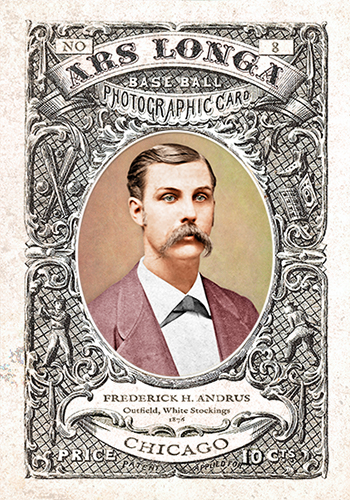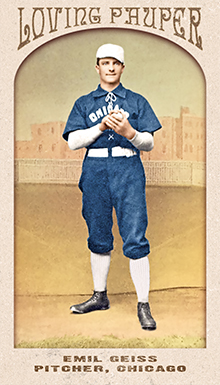
- Series: 1880s: Loving Paupers
- City: Chicago
- Team: White Stockings
- League: National League
- Hall: National Baseball Hall of Fame
John Gibson Clarkson (1861-1909) won 328 games, won the triple crown in 1889 and twice pitched more than 600 innings in a season. In 1885, John appeared in 70 games, threw 68 complete games, 623 innings, won 53, had an ERA of 1.85, a no-hitter, and won the pennant. Apparently having to hurl the sphere a mere fifty feet was a tonic to the arm. But unlike so many pitchers of his era, Clarkson didn’t flame out from such prodigious labor on the mound. From 1885-92 he AVERAGED 36 wins per season and would win 30+ an extraordinary six times. This great career began with the Worcester Ruby Legs in 1882, flowered with Cap Anson’s Sox in ‘84 and fully bloomed in Boston when John followed his ace catcher King Kelly to the Beaneaters in ‘88. League politics that culminated in the Players’ League revolt took a toll on Clarkson’s reputation and sundered his friendship with Kelly as the hurler remained loyal to the Nationals.
- Cleveland acquired John in 1892 allowing him to team with Cy Young. Chief Zimmer, who caught Young for a decade, proclaimed Clarkson the best he ever saw
- Elected to Hall of Fame: 1963
Auction History
Cartophilia
Old Judge Pose: 78-7

- Series: 1880s: Loving Paupers
- City: Chicago
- Team: White Stockings
- League: National League
Joseph Andrews Sommers (1866-1908) was a catcher in the days when the position exacted a heavy toll on its players. Perhaps this accounts for why Pete could last four seasons in the majors despite having no discernible skills in the batter’s box. He hit .181 his rookie year in the lesser circuit of the day, the American Association. He debuted with the New York Metropolitans, a struggling club under Dave Orr’s direction in 1887. Sommers got into a mere 33 games, but did contribute a dozen RBI. The following year Pete moved to the National League where he would remain during his major league tenure with Boston’s Beaneaters, the Chicago White Stockings, Indianapolis Hoosiers, New York Giants and Cleveland Spiders. He split the ‘89 season between Chicago and Indianapolis and was in NY and Cleveland for his final turn in 1890. Overall Sommers managed to hit a combined .198 in these four years. Nevertheless, the risks of being the backstop in the days before modern protective gear were such that a high batting average was hardly necessary to fill in at catcher and Sommers got to be part of some of the noteworthy teams of the decade. His MLB experience was less than half of Pete’s pro career. He had started out with Cleveland’s Forest Cities in the Western League in 1885 and saw limited service as late as 1896 with the Quincy, IL Ravens.
- In ‘92 Pete was a regular with the Terre Haute Hottentots (a simpler time!) of the Illinois-Iowa League where he hit .250
- During his season in the Big Apple, Sommers proved to be a sturdy oak behind the plate. News reports described a collision with Orr that left the player/manager out cold and missing two teeth. Apparently, Sommers and first-baseman Orr were trying for the same pop-up. Unknown if Pete held onto the ball
Auction History
Cartophilia
Old Judge Pose: 430-4

- Series: Mort's Reserve
- City: Chicago
- Team: White Stockings
- League: National League
Frederick Hotham Andrus (1850-1937) had the distinction of making major league baseball a part time occupation. Fred always held gainful employment but stayed close enough to the game to get two opportunities to play at the pinnacle of the sport, both with Chicago. His first brief tour was in 1876 where he played outfield in eight games for the champion White Stockings in the National League's inaugural season. He made a good record, hitting .306 in 36 plate appearances with three doubles and two RBI. Eight years later Andrus returned for a single game for the White Stockings, this time as a pitcher. He completed his start while yielding three runs, two earned, for a “career” ERA of 2.00. Andrus is known to have played for only one official minor league club, Milwaukee of the League Alliance, in 1877. He was one of two managers for the team that year along with Pidgey Morgan. Milwaukee was one of 29 teams vying in the agglomeration known as the League Alliance. It had formed in response to a perceived threat by a rival professional organization, the International Association of Professional Base Ball Players challenging William Hulbert's new National League. Spalding had managed Andrus at Chicago in '76 and was heavily involved with Hulbert in navigating the tumult as the nascent NL established itself as THE major league. In fact, Spalding had founded his famed sporting goods company in 1876, a franchise Andrus would serve as treasurer for eight years beginning with his move to Chicago in 1884. Undoubtedly, it was the high-level connections Andrus had forged in baseball and in business that gave him the entree for his cameo appearance that year back with his old Windy City team.
- Andrus had started out in his native Michigan playing for the Mutuals of Jackson, possibly a successor to one of the earliest organized clubs in America. The Daybreak Club of Jackson had begun in 1860. Jackson had another claim to fame as, in 1854, a meeting “Under the Oaks” just outside of town was the site of the founding of the Republican Party
- Fred left Spalding's company to manage a Detroit real estate concern with which he was still employed at his death from pneumonia at age 87

- Series: Beginnings: 1880's
- City: Chicago
- Team: White Stockings
- League: National League
- Hall: National Baseball Hall of Fame
Hugh Duffy (1866-1954) is as much a baseball institution as the Hall of Fame that enshrines him. For 68 years he devoted himself to the game he loved and excelled at as few ever have. In 1894 he set the all-time mark with a .440 average while winning the triple crown. He made HOF pitchers look like batting practice coaches: .586 against John Clarkson, .650 vs Cy Young. Amos Rusie was the exception, holding Duffy to a mere .333. So diminutive Cap Anson nearly dismissed him (“We already have a bat boy”), Hugh hustled his way to becoming the only player to hit .300 in four leagues and let the power follow his form (“hit ‘em up the middle”) winning two HR titles. Duffy went on to coach, manage, scout and mentor for a half-century after hanging up his spikes. He was still hitting fungoes eight years after his induction into Cooperstown and delighted in pupil Ted Williams’ success as he sought in vain to eclipse Duffy’s record in 1941.
- Playing career spanned 19 years, primarily in Chicago, Boston and Philadelphia
- Played center field for the Beaneaters next to his “Heavenly Twin,” Tommy McCarthy in right, leading Boston to a pair of pennants
- Elected to Hall of Fame: 1945

- Series: 1880s: Loving Paupers
- City: Chicago
- Team: White Stockings
- League: National League
Emil Geiss (1865-1911) emigrated from his birthplace, Villmar Germany, to Chicago. The youngster began his experience in professional baseball out in Colorado with the Pueblo Pastimes of the CO State League in 1885. The scanty records for minor league play in those days record Emil started two games, finished them both and went 1-1. There is no data for Geiss’ activities the following year, but one might suppose he did something somewhere to impress the Chicago White Stockings as the National League power thought fit to sign Emil for the ‘87 season. Whatever Cap Anson’s hopes were, they died aborning as Geiss languished with the team. He got shelled in his one start (11 runs, eight earned) and not only left the major leagues, he left his adopted land. Geiss signed the following two seasons with London Ontario Canada’s Tecumsehs of the International Association and stayed for the 1889 campaign when the Tecumsehs joined the International League. In those two years Geiss was 21-21 . But for his sole outing in Chicago, he would have completed his pro tenure with a symmetrical record of 22-22.
- There is no doubt Emil belonged in the pitcher’s box as his hitting gave no indication he could perform anywhere else. He never cracked the .200 mark and was one for 12 with the White Stockings. His three errors in his brief time in the majors suggest it wasn’t just his bat that would be a detriment to longevity at that level
- The reason Geiss had twelve at bats in Chicago is that Anson put him at first base and second base in two other appearances
- Emil’s older brother Bill also saw major league duty, playing two seasons. He debuted with Baltimore in the American Association in 1882 and then joined the Detroit Wolverines of the NL in ‘84
Auction History
Cartophilia
Old Judge Pose: 182-2




